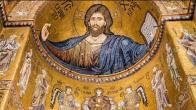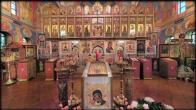You are here
Great Martyr Ketevan, queen of Kakhetia, Georgia
13/26 September
Great-martyr Ketevan was of the royal house of Bagration, and was the great-granddaughter of King Constantine of Kartli (1469-1505). Having married David, heir to King Alexander II of Kakhetia (1577-1605), she herself ruled the kingdom. The queen’s profound piety was manifested in her particular concern for the needs of the Georgian Church, in her building of churches, orphanages, and hostels. Following her husband’s death, St. Ketevan became a solitary.
Her husband’s brother Constantine, known as the Accursed, adopted Islam, and at the instigation of Shah Abbas I dispatched assassins to kill his aged father, King Alexander II, and his brother Georgi. After committing this crime, Constantine ordered that the bodies of the murder victims be packed on camels and taken to Queen Ketevan. Horrified by the evil deed, the queen mourned the innocent victims and buried them in the Cathedral of Alaverdi. The impious one, however, made an attempt to encroach upon her honorable widowhood and asked for her hand, threatening her with force should she refuse.
Assembling the people of Kakhetia, Queen Ketevan took up arms against Constantine, and defeated the impious apostate. Together with a multitude of Persian warriors, he suffered an ignominious death. Under the wise rule of Queen Ketevan, peace and justice settled in Kakhetia. Shah Abbas I returned her son Teimuraz to her. Although Teimuraz lived for a number of years as a hostage in the Shah’s court, he maintained his Orthodox faith unsullied. Later, making threats that he could decimate Georgia, Shah Abbas forced the Kakhetian vassals to give up some important hostages. Queen Ketevan volunteered to be one of those hostages. Desiring to turn looming misfortune away from the Georgian people and the Holy Church, she went to Isfahan. Shah Abbas offered the righteous queen the opportunity to adopt Islam, but received a firm refusal. Then Queen Ketevan was cast into a dungeon in which she spent 10 years of suffering and torture. Nothing could shake the resolve of the one who suffered for Christ’s sake: not the Persian courtiers’ dirty tricks, not the Shah’s sly proposal to make her queen of the Persian state, not the offers of great treasures, not the appeals and prayers of the courtiers and important personages of Persia to spare herself by saying only a single blasphemous word against Christ. They crucified her on a tree, and tortured her with red-hot pincers. They placed a red-hot iron kettle upon her head. Thick smoke arose from her burning hair and head, and the Blessed Martyr gave up her holy soul to God On September 13, 1624.
As a sign of her spiritual victory, three pillars of light were seen descending upon the body of St. Ketevan. Queen St. Ketevan’s relics were translated to Rome, to the Cathedral of the Holy Apostle Peter, by monks of the Augustinian Order, who had witnessed the spiritual struggle of the confessor. Portions of her relics (the Martyr’s honorable head and right arm) were given by the Augustinian monks to King Teimuraz I and were placed under the Altar Table in the Cathedral of Great-martyr George in the Monastery of Alaverdi, Kakhetia. Catholicos-Patriarch Zachary (1613-1630) declared the Great martyr to be among the ranks of the Saints, and instituted September 13th as the day of her commemoration.
Relics in cathedral - monthly calendar
| S | M | T | W | T | F | S |
|---|---|---|---|---|---|---|
|
|
|
|
1
|
2
|
3
|
4
|
|
5
|
6
|
7
|
8
|
9
|
10
|
11
|
|
12
|
13
|
14
|
15
|
16
|
17
|
18
|
|
19
|
20
|
21
|
22
|
23
|
24
|
25
|
|
26
|
27
|
28
|
29
|
30
|
31
|
|
PARISH LIFE
Address of our Cathedral
While all the materials on this site are copyrighted, you may use them freely as long as you treat them
with respect and provide attribution on the Russian Orthodox Cathedral of St.John the Baptist of Washington DC.









